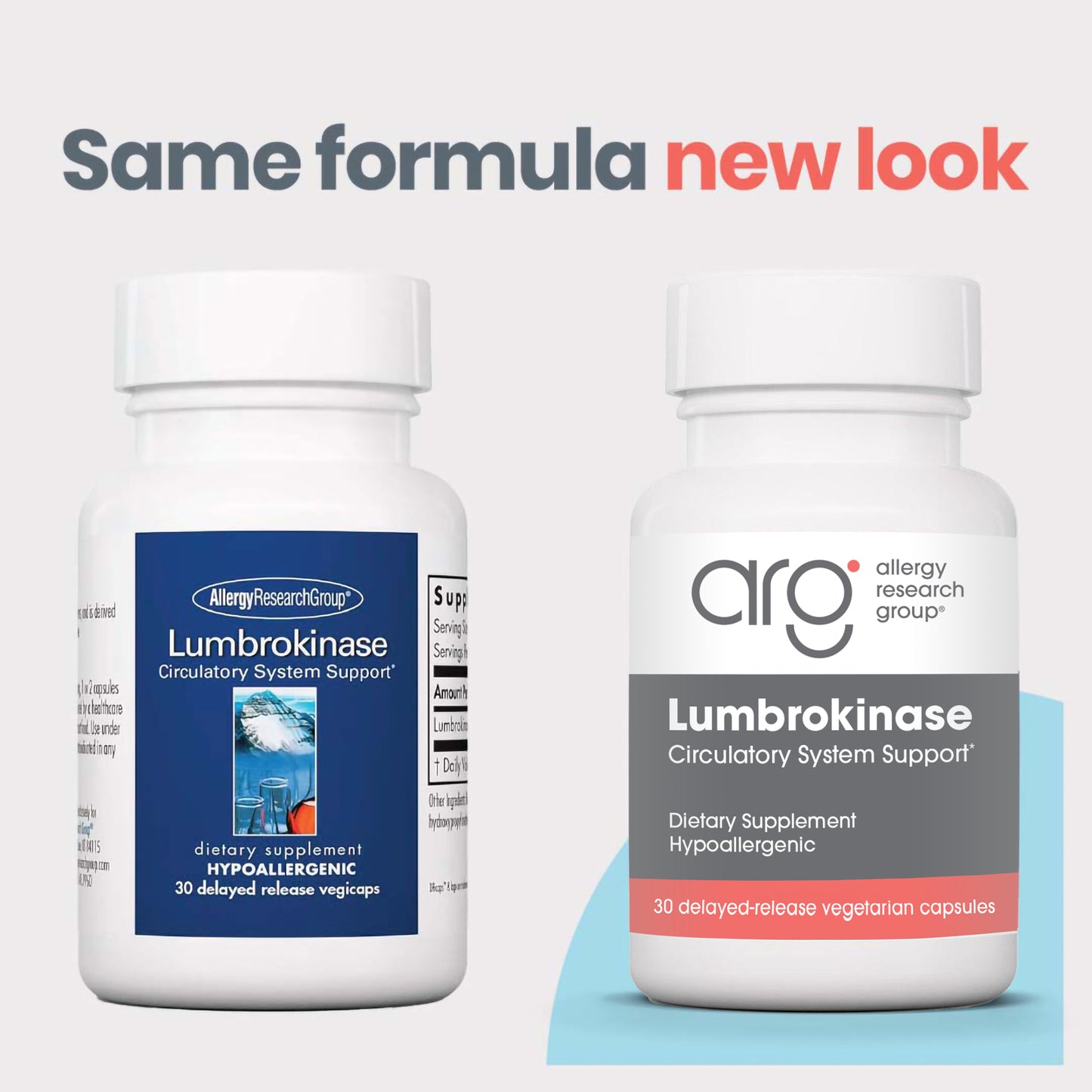













SKU:74870
Lumbrokinase Circulatory System Support*
Lumbrokinase Circulatory System Support*
Circulatory System Support*
Product Description
Lumbrokinase is a group of earthworm-derived proteolytic enzymes that support cardiovascular health by promoting healthy fibrin breakdown, blood flow, and platelet function.* Backed by clinical research, lumbrokinase helps maintain normal blood viscosity and circulation without unwanted effects.* ARG’s lumbrokinase is delivered in acid-resistant, delayed-release capsules for optimal activity.* Lumbrokinase is derived from the earthworm Lumbricus rubellus
Couldn't load pickup availability







-
Ingredients -
Product Information -
Suggested Use
Ingredients:
Serving Size: 2 capsules
Servings Per Container: 15 or 30
Amount per serving:
Lumbrokinase (600,000 IU): 32 mg
Other Ingredients:
Rice dextrin, medium chain triglycerides, hydroxypropyl methylcellulose, water, gellan gum, microcrystalline cellulose.
Clinically studied systemic proteolytic enzymes for circulatory and cardiovascular support.*
What It Does
Lumbrokinase Circulatory Systemic Enzymes supports healthy blood flow, platelet function, and fibrin breakdown to promote optimal cardiovascular health.* These earthworm-derived proteolytic enzymes act systemically to help maintain blood viscosity and support the body's natural fibrinolytic pathways.*
How It Works
• Lumbrokinase (from Lumbricus rubellus): A group of six proteolytic enzymes that primarily target fibrin and fibrinogen, promoting healthy clot breakdown while sparing other plasma proteins.* [1-2]
• Systemic Enzyme Activity: Functions beyond digestion to support cardiovascular and circulatory health by enhancing the body’s natural fibrinolytic mechanisms.* [3]
• Evidence-Based Benefits: Multiple clinical studies, including trials at Beijing Xuanwu Hospital, have demonstrated support for normal circulation, blood flow, and vascular function.* [4-6]
• Delayed-Release Delivery: Encapsulated in acid-resistant, delayed-release capsules using gellan gum to protect enzyme activity as it passes through the stomach.*
Who It’s For
Ideal for individuals seeking support for circulatory health, fibrin balance, and systemic enzyme therapy to enhance cardiovascular wellness.*
Special Features
• Systemic Proteolytic Enzyme Formula: Specifically targets fibrin while sparing other essential plasma proteins like plasminogen and albumin.*
• Phthalate-Free Delayed Release: Gellan gum-based acid resistance ensures optimal enzyme delivery without synthetic coatings.*
• Traditional and Modern Integration: Earthworm-derived enzymes with a long history of use in Eastern medicine and validation through modern clinical research.*
Lumbrokinase Circulatory Systemic Enzymes deliver targeted, clinically researched systemic enzyme support for circulatory and cardiovascular health, with clean, delayed-release delivery to preserve activity and effectiveness.*
References
¹ Mihara H, et al. Jpn J Physiol. 1991;41(3):461-472. doi:10.2170/jjphysiol.41.461
² Nguyen QTT, et al. BioMed Res Int. 2023. doi:10.1155/2023/4050730
³ Verma NK, et al. Int J Bio-Sci Bio Tech. 2011;3(2).
⁴ Chen Y, et al. Trials. 2022;23(1). doi:10.1186/s13063-022-06200-4
⁵ Cao Y, et al. Chin Med J. 2013;126(21). doi:10.3760/cma.j.issn.0366-6999.20131332
⁶ Wiyarta E, et al. Stroke Vas Int Neurol. 2024;4(S1). doi:10.1161/svin.04.suppl_1.099
⁷ Kasim M, et al. J Altern Complement Med. 2009;15(5):539-544. doi:10.1089/acm.2008.0506
⁸ Sukmawan YP. Indones J Clin Pharm. 2020;9(1):43. doi:10.15416/ijcp.2020.9.1.43
Suggested use:
As a dietary supplement, take 2 capsules twice daily, or as directed by a healthcare practitioner. Take with 8-10 oz of water.
Warning:
If you are pregnant or lactating, have any health condition or are taking any medication, consult your healthcare practitioner before use. Use under medical supervision if taking anticoagulant drugs. Do not use in any condition associated with bleeding.
Store in a cool, dry place, tightly capped, away from light. Keep out of the reach of children. Use only if safety seal is intact. Variations in product color may occur.
Stay Connected
Sign up and we’ll keep you up to date on the latest news, clinical education resources, product innovations and promotions.
